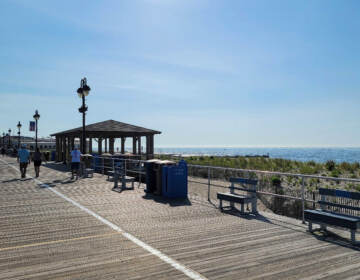Volunteer firefighters save numerous swimmers in churning surf
Volunteer firefighters from the northern Ocean County barrier island responded to at least six water rescue calls in dangerous ocean conditions Monday.

Waves in South Seaside Park on Sept. 20, 2019. (Justin Auciello/WHYY)
Volunteer firefighters from the northern Ocean County barrier island responded to at least six water rescue calls in dangerous ocean conditions Monday.
For days, the National Weather Service has been warning about a high risk of rip current development — powerful channels of water flowing quickly away from the shore — as Hurricane Paulette lurked hundreds of miles away from New Jersey.
But now with most beaches without lifeguard protection until the weekends, swimmers were extremely vulnerable on Monday, and volunteer firefighters were ready to respond.
Bobby Ring, a volunteer firefighter with the Seaside Park Fire Company, said the department’s water rescue unit responded to six rescue calls in a span of a few hours.
The first call came in at 11:30 a.m. for a response in nearby Lavallette, followed shortly by Island Beach State Park, South Seaside Park, Seaside Park, and Seaside Heights, he said, adding that the South Seaside Park call involved five swimmers needing rescue.
“Several people were transported to the hospital,” a posting on the Seaside Park Fire Company Facebook page stated.
Their conditions and the locations where they were rescued were not immediately available.
The National Weather Service expects a high risk of rip current development to continue for Tuesday as dangerous swells from the distant Hurricane Paulette reach the coast.
How to identify a rip current:
- A channel of churning, choppy water.
- An area having a notable difference in water color
- A line of foam, seaweed, or debris moving steadily seaward
- A break in the incoming wave pattern.
If caught in a rip current, NOAA advises:
- Stay calm.
- Don’t fight the current.
- Escape the current by swimming in a direction following the shoreline. When free of the current, swim at an angle—away from the current—toward shore.
- If you are unable to escape by swimming, float or tread water. When the current weakens, swim at an angle away from the current toward shore.
- If at any time you feel you will be unable to reach shore, draw attention to yourself: face the shore, call or wave for help.
WHYY is your source for fact-based, in-depth journalism and information. As a nonprofit organization, we rely on financial support from readers like you. Please give today.




